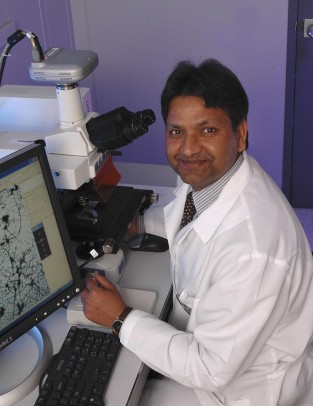Gene activity links anxiety, alcohol use
Alcohol exposure reduces anxiety by normalizing processes of nerve transmission in an area of the brain area involved in emotions, researchers at the University of Illinois at Chicago College of Medicine have found.
The study, performed in laboratory rats and published online in the Journal of Biological Psychiatry, suggests new targets for drugs to combat alcoholism.
People with alcoholism often have problems with anxiety, says Subhash Pandey, professor and director of neuroscience alcoholism research at UIC and research career scientist at the Jesse Brown VA Medical Center.
To explore that link, he and his coworkers studied rats that were selectively bred to have either a high or low thirst for alcohol.
“The high-preference animals, like many humans who drink heavily, display a high level of anxiety,” Pandey said.
In the rats with the high preference for alcohol, the researchers found high levels of a molecule called HDAC2 that changes the way the DNA of the chromosomes is wound up in cells. How the DNA is spooled has an important effect on which genes are expressed.
The researchers found that the alcohol-craving rats had very tightly packed DNA in the amygdala — the brain center responsible for fear, emotion and anxiety.
When given alcohol, these animals became less anxious. The researchers discovered that alcohol inhibited the dense packing of DNA in the amygdala, “opening it up” and allowing the expression of genes that adjust conduction of nerve impulses and are associated with reduced anxiety.
“This makes sense,” Pandey said, since diminished ability to adjust nerve transmission “has been implicated in anxiety and alcoholism.”
The researchers then lowered the rats’ HDAC2 levels using small interfering molecules called silencing RNAs. Again, the spooled DNA opened up, the expression of the genes increased, and animals’ anxiety lessened. But in addition, the animals dramatically reduced their intake of alcohol, no longer showing their inbred preference for strong drink. They did not stop drinking non-alcoholic liquids.
The study, Pandey said, suggests a causal role for HDAC2 in changing DNA packaging and regulating anxiety and alcohol-drinking behavior.
“We believe that HDAC2-specific inhibitors may prove useful as therapeutic agents for the treatment of both alcoholism and anxiety,” he said.
Sachin Moonat, a graduate student in psychiatry at the UIC College of Medicine and the Jesse Brown VA Medical Center, is first author of the study. Other authors are Amul Sakharkar, Huaibo Zhang and Lei Tang, also of the UIC department of psychiatry and the Jesse Brown VA Medical Center.
The study was supported by grants from the National Institute on Alcohol Abuse and Alcoholism grants AA-013341, AA-016690, AA-019971 and AA-010005; the Department of Veterans Affairs and NIAAA Alcohol Resource grant R24AA-015512.
The University of Illinois Hospital & Health Sciences System provides comprehensive care, education and research to the people of Illinois and beyond. The UI Health System includes a 495-bed tertiary hospital; the University of Illinois at Chicago colleges of Medicine, Dentistry, Pharmacy, Nursing, and Applied Health Sciences, the UIC School of Public Health and UIC’s Jane Addams College of Social Work; 22 outpatient clinics located in Chicago; 12 federally qualified health centers throughout the city; and College of Medicine and affiliated health care facilities in Urbana, Peoria and Rockford.
For more information: The University of Illinois Hospital & Health Sciences System

